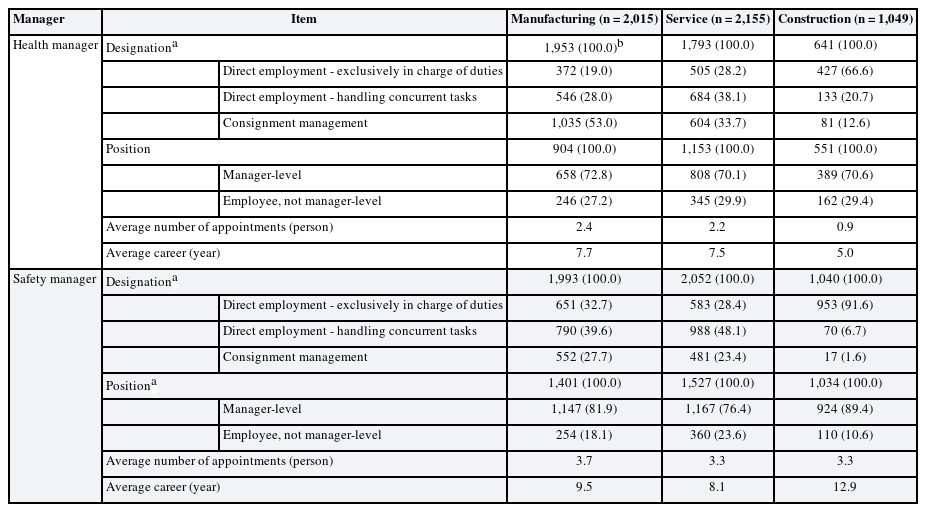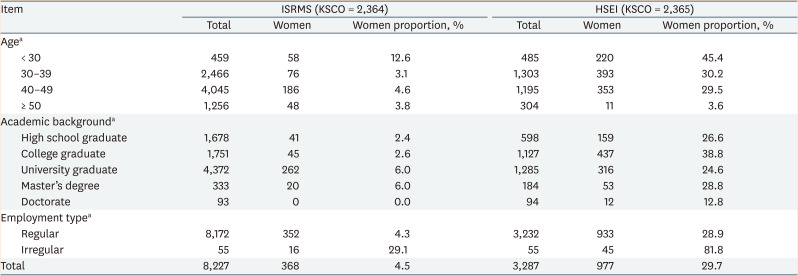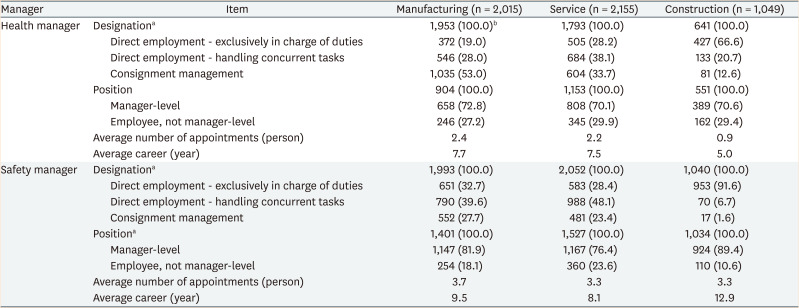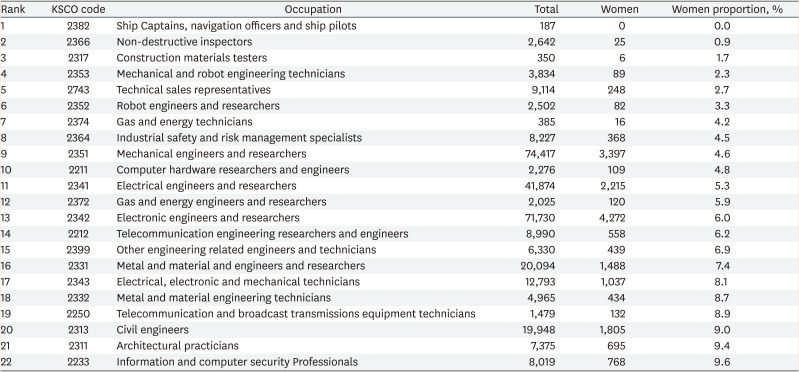Distribution of Korean safety and health professionals from the perspective of gender equality
Article information
Abstract
Background
Gender equality in the workplace remains a challenge. This study aimed to investigate the gender gap of human resources in the field of occupational safety and health (OSH) in Korea.
Methods
Several national statistical data that can confirm the gender distribution of personnel in the OSH sector were reviewed. The gender distribution of industrial technical manpower statistics, professional certificate holders in the OSH field, and the status of the appointment of safety and health managers by industry was analyzed.
Results
The distribution of professionals in the OSH sector in Korea had a large gender gap with a small number of women. In particular, the proportion of women in the safety field was lower than that in the health field. In the younger age group, while the proportion of women is increasing, the gender gap tends to decrease.
Conclusions
Few data are available to understand the gender-related aspects of OSH professions. Nevertheless, our results provide basic information for initiating a discussion on the necessity of establishing gender-sensitive culture and policies in the OSH sector.
BACKGROUND
In the field of occupational safety and health (OSH), the need for research based on gender, which means socially constructed characteristics, has been raised beyond the concept of sex, which means biological differences between men and women.12 In particular, since the employment of paid work is greatly influenced by the socio-cultural characteristics of masculinity and femininity, this paper intends to use the term gender instead of sex. Gender equality in the workplace has seemingly improved in some aspects, albeit modestly,3 a recent United Nations report shows that gender inequality has even expanded since the coronavirus disease 2019 (COVID-19) outbreak, thereby posing a particularly serious threat to the achievement of sustainable development goals, including gender equality and women’s economic empowerment and decent work.4 The International Labor Organization (ILO) estimated that 527 million women, representing 41% of women employees worldwide, were employed in sectors at high risk of severe COVID-19 impact in terms of job security in 2020. Meanwhile, 35% of male workers were employed in high-risk sectors related to COVID-19.5
The Korean government has introduced policies to promote gender equality and close the gender gap. Prohibiting discrimination against women workers was firstly promulgated in the “Labor Standard Act” legislated in 1953, and the “Equal Employment Opportunity and Work-Family Balance Assistance Act,” including the prohibition of sexual harassment, was enacted in 1987.6 The institutional mechanism for promoting gender equality has been established since the enactment of the “Framework Act on Women’s Development” in 1995, followed by the “Framework Plan on Gender Equality Policies,” thus setting up the basic strategies and goals of women’s policy. The Ministry of Gender Equality and Family (MOGEF) was established in 2001.7 Since then, the paradigm of women’s policy has shifted from “women development” to “gender equality.” With that, the “Framework Act on Women’s Development” was revised to the “Framework Act on Gender Equality” in 2014. Based on this Act, the First (2015–2017) and Second Master Plans for Gender Equality Policies (2018–2022) have been introduced by the MOGEF.8
Although the Korean government has implemented acts and policies that promote a gender-responsive work environment, the Global Gender Gap Index 2021, reported by the World Economic Forum, shows that Korea has closed 68.7% of its gender gap to date, thereby ranking the country 102 out of 156 globally.9 According to The Economist’s latest glass-ceiling index, which ranked the conditions for working women across 29 countries, South Korea scored just 24.8 out of 100, which was less than half of the average for the OECD club of industrialized countries, and it was ranked last among 29 countries.10
Since 2014, the Korean “Occupational Safety and Health Act” (OSHAct) has required the appointment of health managers at construction sites,11 and many female health management personnel have been employed as contract workers during construction projects. In addition, the “Severe Accident Punishment Act” has recently been enacted and is set to take effect in 2022.12 It requires employers to adopt health and safety management systems to prevent such accidents and imposes heavy criminal and administrative liabilities on companies and their senior officers if failure to do so results in serious accidents. Therefore, employers should strengthen their safety and health management systems to prevent serious accidents, and this is expected to increase the demand for safety and health personnel. However, to date, there have been no studies on the gender characteristics for safety and health personnel.
In this study, we aimed to analyze a series of workforce statistics available in the OSH sector from a gender equality perspective.
METHODS
Few statistics on women working in the OSH sector in Korea are available. Industrial technology manpower (ITM) data13 and professional certificate holders in the OSH field14 were reviewed for this study. Among the results of the 2018 OSH survey15 conducted by the Occupational Safety and Health Research Institute (OSHRI) of Korea, the status of the appointment of safety and health managers by industry was also reviewed. The characteristics of the data sources and the detailed analysis methods are as follows:
Supply and demand status of ITM
Since 2005, the Korea Institute for Advancement of Technology (KIAT) has conducted an annual survey on the supply and demand of ITM by industry, occupation, and region. Industries were classified according to the 10th Korea Standard Industry Classification, and occupations were investigated according to the 7th Korean Standard Classification of Occupations (KSCO).
In 2019, the KIAT surveyed 12,646 businesses with more than 10 employees in the manufacturing and service sectors for 145 jobs.13 We compared the gender distribution of current personnel data by employment type, academic background, and age for seven sector manager-level jobs, “industrial safety and risk management specialists (ISRMSs; KSCO = 2364),” and “health, sanitation, and environmental inspectors (HSEIs; KSCO = 2365)” among the survey results in 2019. An ISRMS is an expert in the safety management field and conducts industrial accident cause investigation, industrial accident prevention activities, and risk diagnosis. An HSEI is an expert in the health and environment field and performs evaluation and management of hazardous agents in the air, water quality, food, and working environment.
Professional certificate holders in OSH Sector
The Human Resources Development Service of Korea announces the status of acquisition of national technical qualifications (NTQs) every year, and statistics on acquisition status by gender have been added since 2015. The NTQ grade is a national technology qualification stage that is assigned differently depending on the level of job performance held by technical personnel. For the safety management field, the grade is divided into three classes: professional engineers at the highest level, engineers, and industrial engineers.
Among the NTQ statistics published in 2020,14 we reviewed the status of obtaining NTQs in the safety management field by gender from 2015 to 2019. Notably, NTQs related to safety management are subdivided into industrial safety, construction safety, fire identification evaluation, gas, industrial hygiene management, fire-fighting equipment (machinery), and fire-fighting equipment (electricity). The status of gender acquisition of national certificates in each safety management field was compared by the grades of professional engineers, engineers, and industrial engineers.
OSH Survey
The 2018 survey was conducted to secure basic data for the establishment of industrial safety and health policies in Korea by investigating 2,000 manufacturing workplaces, 2,000 other industries with 50 or more employees nationwide, and 1,000 construction sites with construction costs of 12 billion won (about USD 10 million) or more.15 In this study, the status of the appointment of safety and health managers was compared by industry.
Statistical analysis
The difference in gender distribution of the collected data was analyzed through the chi-square test. Statistical significance was defined as p < 0.05. All statistical analyses were performed using R version 4.1.016 and Microsoft Excel.
Ethics statement
This study used only de-identified database disclosed to the public without personal identification information.
RESULTS
The distribution characteristics of ITM in the field of safety and health surveyed in 2019 are summarized in Table 1. The total number of ISRMSs was 8,227, while 368 were women, accounting for only 4.5%. The number of HSEIs was 3,287, less than ISRMSs, and the female proportion thereof was 29.7%, approximately six times higher than ISRMSs. The distribution of male and female ITM by age, academic background, and employment type showed statistically significant differences (p < 0.01). The proportion of women under the age of 30 years was 12.6% of ISRMSs and 45.4% of HSEIs, respectively, higher than those over the age of 30 years. The number of male ISRMSs with a doctorate was 93, but female doctorate ITM accounted for none. In terms of employment type, the proportion of irregular female ITM (ISRMSs = 4.3%, 16/368; HSEIs = 4.6%, 45/977) was approximately nine times higher than that of male ITM (ISRMSs = 0.5%, 39/7,859; HSEIs = 0.4%, 10/2,310).
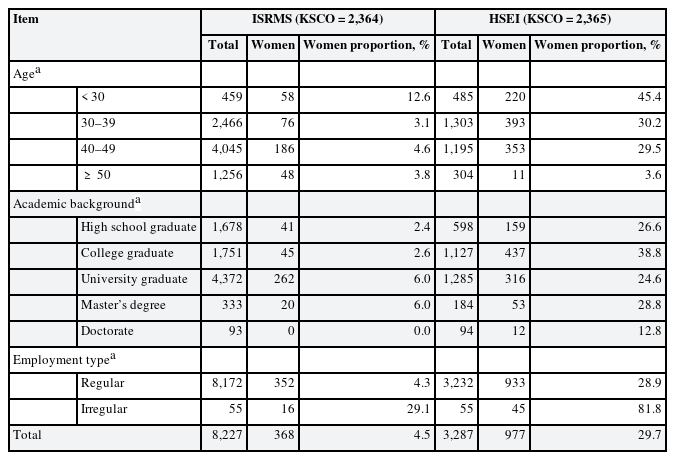
Comparison of industrial technology manpower in the field of occupational safety and health management in 2019 by gender
Fig. 1 shows the gender distribution of manager-level ITM in seven fields in 2019. The proportion of women in “health and medical service managers” was the highest at 23.8%, while the proportion of women in the remaining six areas was lower than 4%.
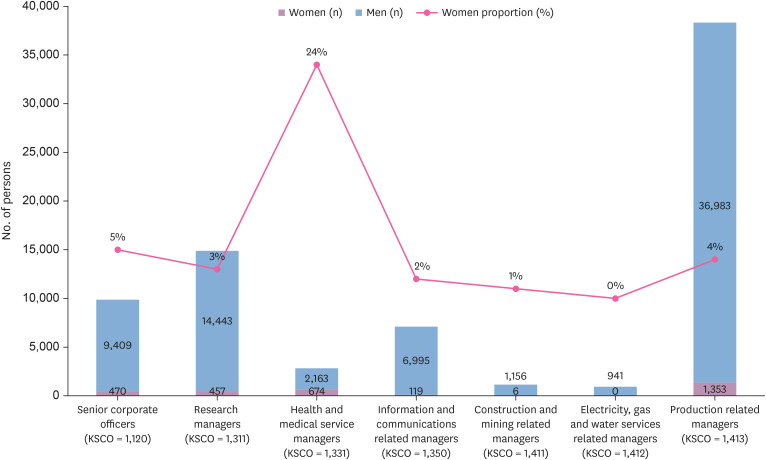
Gender distribution of manager-level industrial technology manpower in several fields in 2019.
KSCO: Korean Standard Classification of Occupations.
In the case of the status of obtaining NTQs related to safety management over the past five years, the number of total acquisitions has been increasing, whereas the percentage of female acquisitions has not changed (Fig. 2). In 2019, the percentage of female certification was 4% for professional engineers (15/361), 12% for engineers (3,480/29,956), and 7% for industrial engineers (1,694/25,140). Fig. 3 shows the NTQ acquisition status by the detailed safety management area. For construction safety with the largest number of professional engineer acquisitions, the percentage of women in 2019 was 1% (Fig. 3A). Regarding obtaining engineering and industrial engineering certificates, the industrial hygiene sector related to occupational health management tasks exceeded 40%, representing the highest percentage of women acquisition (Fig. 3B and C).
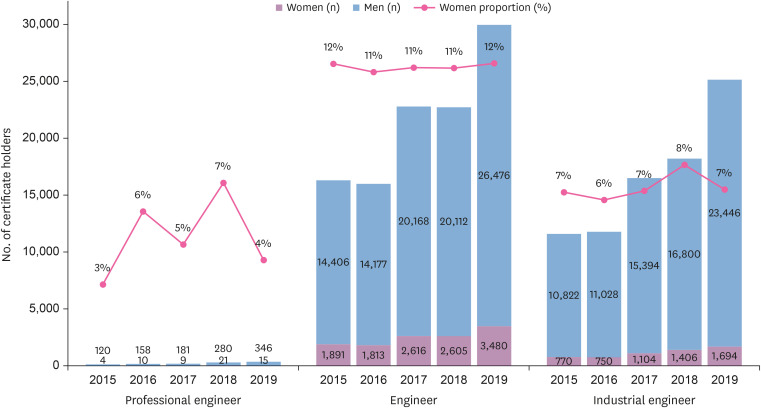
Status of acquisition of national technical qualifications in the fields of safety management by gender from 2015 to 2019.
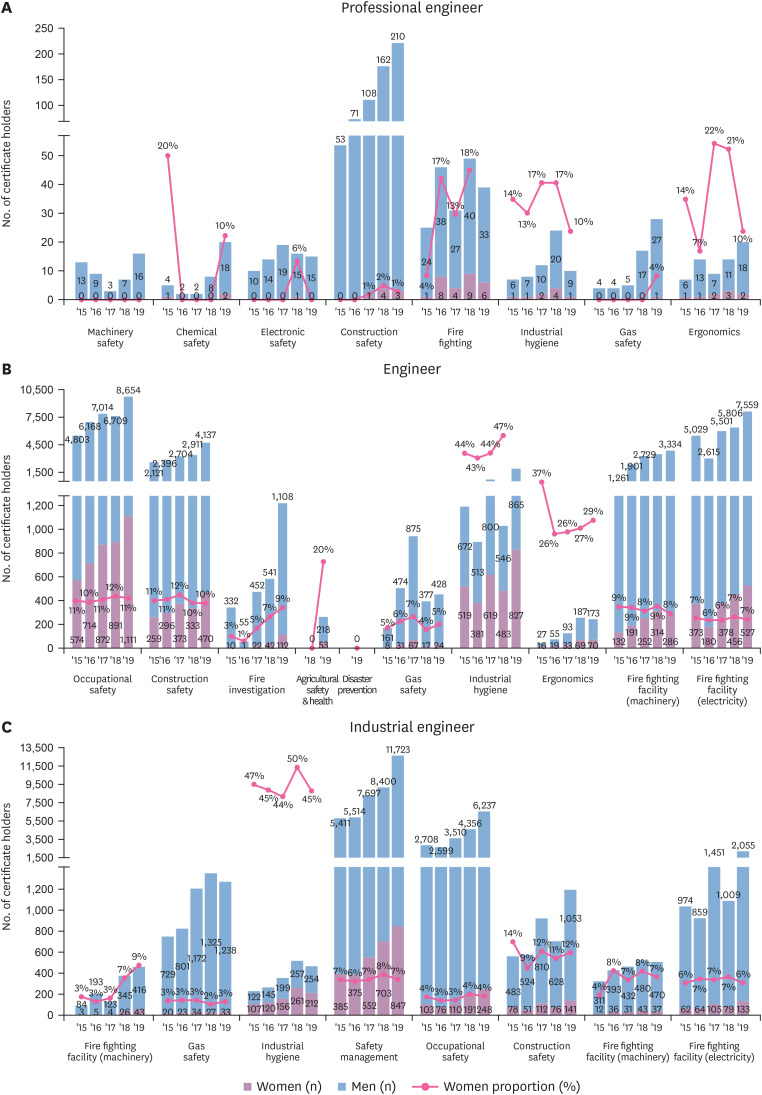
Status of acquisition of national technical qualifications in the specific fields of safety management by gender from 2015 to 2019.
The results of the OSH survey on the appointment of health and safety managers by industry in 2018 are summarized in Table 2. The number of health and safety managers according to the type of designation differed significantly by industry (p < 0.01). Direct employment in the construction industry (health manager = 87.4%, safety manager = 98.4%) was higher than in the manufacturing industry (health manager = 47.0%, safety manager = 72.3%) and service industries (health manager = 66.3%, safety manager = 76.6%). Within the same industry, safety managers had a higher percentage of direct employment and managerial positions, average number of appointees, and average career than health managers. In particular, the construction industry had a greater difference in the designated characteristics of both safety and health managers than in the manufacturing and service industries. For construction safety managers, the direct employment rate was 98.4%, and the managerial position rate was 89.4%, compared with 87.4% and 70.6%, respectively, for health managers. The average number of construction safety managers at work sites was 3.3, similar to other industries (manufacturing = 3.7, service = 3.3), while the number of health managers was 0.9, which was a big difference from other industries (manufacturing = 2.4, service = 2.2). In addition, the average construction safety manager’s career was 2.5 times longer than that of health managers.
DISCUSSION
In this study, we attempted to identify the gender distribution and characteristics of OSH sector experts. However, few data are available to understand the gender-related aspects of OSH professions. In the case of statistics on the acquisition of NTQs, gender analysis began in 2015. In the case of the OSH survey conducted by the OSHRI, the status of the appointment of health and safety managers did not result in sex-disaggregated data collection. Gender-specific data analysis is necessary to understand the health and safety gaps between women and male workers and create policies that consider the differences between women and men in the workplace.17 According to a study on the health inequality of Korean wage workers, female workers reported a higher risk of work-related musculoskeletal disease than male workers.18 In 2006, the World Health Organization published an extensive list of recommendations on sex-disaggregated data collection and analysis for occupational exposures, diseases, and injuries.19 In the ILO report,20 the lack of sex-disaggregated data makes it more difficult to identify hazards, risks, and types of occupational injuries and diseases that specifically affect each gender, thereby impeding the development of effective OSH policies.
The number of ITM in Korea’s OSH sector showed a very large gender gap (Table 1). In the past five years, NTQ acquisitions in the safety and health sectors have been steadily increasing, but the proportion of women has not changed (Fig. 2). However, in younger age groups, the gender gap showed a decreasing trend. In the 2019 ITM, the proportion of young women under the age of 30 years was relatively higher than those over the age of 30. (Table 1). However, the proportion of women was lower than 4%, except for the health service profession in the ITM at the managerial level (Fig. 1). Therefore, it is highly likely that most senior managers of organizations where young female health and safety professionals work are men. Several studies have shown that women in organizations have a lower promotion rate than men.212223 Stamarski and Son Hing24 suggested that to reduce discrimination, organizations should focus on human resource practices, organizational structures, processes, and the reduction of organizational decision-makers’ level of sexism.
The gender distribution of professionals in the safety and health fields showed different characteristics. According to the ITM data, the proportion of female workers in the safety sector was 4.5%, which was lower than that of the health sector (29.7%) (Table 1). Compared to other professional occupations with similar skill levels to safety and health professionals, the proportion of women in the safety sector was the eighth lowest (Table 3).13 The proportion of women in construction, machinery, and engineering technology, traditionally recognized as male-dominated jobs, was lower than 10%. Globally, the patterns of gender segregation by occupational group are relatively similar. Some occupations such as craft and related trades workers, plant and machine operators and assemblers, and managers are primarily done by men, while jobs in other occupation including services and sales workers and professional groups are overwhelmingly done by women.25

Comparison of professional occupations with less than 10% of women among industrial technology manpower in 2019
Given the status of NTQ acquisition by safety and health details, the proportion of women in the safety sector is also lower than that in the health sector where industrial hygiene experts work (Fig. 3). In the case of construction safety with the largest number of professional engineers, the percentage of female professional engineer acquisitions in 2019 was very low at 1%. Under the Korean OSHAct, health manager qualification conditions are defined as doctors, nurses, health-related certificates, or health-related college graduates. Therefore, it is predicted that the proportion of women health managers will be higher than that of safety managers. Unfortunately, however, the gender distribution of actual safety managers and health managers appointed in workplaces could not be determined. The OSH survey conducted by KOSHA did not investigate the gender distribution of safety and health managers (Table 2).
The OSH survey results also show that the average number of safety managers in the construction industry is approximately 3.5 times higher than the number of health managers (Table 2). In terms of the regulations on the appointment of safety and health managers, the Korean OSHAct revised in 1990 stipulates that one or more safety managers should be appointed at construction sites with the value of construction work exceeding 5 billion won (about USD 4.3 million).26 However, in the case of health managers, regulations have been implemented since 2014 to appoint one or more health managers at sites with construction costs of 80 billion won (about USD 68.4 million) or more.12 Therefore, health managers in the construction industry are younger and have less experience in health management than safety managers.
ILO economists studied the cause of the gender gap by industry and occupation and suggested that personal preferences, socio-economic constraints, and gender role conformity were driving gender gaps in the labour market.25 They found the following negative factors as obstacles to women’s employment. In developed countries, women are less likely to participate in the labor market if they have a spouse or partner. Limited access to safe transportation is the greatest challenge for women facing in developing countries. Globally, the lack of affordable care for children or family members hinders women from participating in the labor market. In terms of the industry- and job-segregation by gender, there has been a tendency for men and women to engage in different industries and occupations due to socialization in the norm that there is something ‘suitable’ for women or men. This could explain the situation of men in construction sites and automobile manufacturing plants and women in caring work and sales service jobs. This gender stereotype limits vocational training and educational opportunities for women and aggravates the gender employment gap. Women are more likely to experience organizational discrimination, which seems to cause women’s lower positions in the hierarchy and higher turnover. Kapsos et al.27 found that severe occupational segregation resulted in 20.7 million fewer women employed in India over the period from 1994 to 2010.
There is a widespread perception that men have more ‘power,’ ‘skills,’ ‘technology’ and ‘leadership.’ Men with more opportunities for obtaining education and training have better access to certain industries, occupations, or higher positions, and more stable and highly paid jobs. Statistical analysis presents that the proportion of women in the safety and health field has been increasing recently due to changes in social perception, challenges of women, expansion of educational opportunities, changes in organizational culture, and changes in laws and regulations. However, it is still challenging for women to enter the very ‘traditional’ male-dominated areas, such as the construction and firefighting sectors. Following approaches can be considered in order to address this phenomenon: more active education and technical opportunities, affirmative action, expansion of social awareness, organizational democracy, eradicating gender discrimination, prevention all kinds of violence at the organizational level etc.
The strength of this study is that data on safety and health professionals are analyzed from the perspective of gender equality. To the authors’ knowledge, this is the first attempt in Korea to analyze the OSH personnel data from a gender equality perspective. This study has a limitation. First, accurate gender characteristics in the field of safety and health could not be analyzed. For example, in the case of the OSH survey data, the gender distribution of both safety and health managers could not be confirmed. Second, due to information restrictions, it was not possible to analyze gender differences in specific working conditions such as salary and promotion opportunities for safety and health professionals. In the future, it is necessary to collect and analyze national data related to safety and health
CONCLUSIONS
The distribution of professionals in the OSH sector in Korea had a large gender gap with a small number of women. In particular, the proportion of women in the safety field was lower than that in the health field. In the younger age group, the proportion of women is increasing, and the gender gap tends to decrease. Few data are available to understand the gender-related aspects of OSH professions. Nevertheless, our results provide basic information for initiating a discussion on the necessity of establishing gender-sensitive culture and policies in the OSH sector.
ACKNOWLEDGEMENTS
The authors would like to thank the survey participants and Occupational Safety and Health Research Institute (OSHRI) for providing raw 2018 Occupational Safety and Health survey data. The paper's contents are solely the responsibility of the authors and do not necessarily represent the official views of OSHRI. This work was supported by Soonchunhyang University.
Notes
Competing interests: The authors declare that they have no competing interests.
Author Contributions:
Conceptualization: Choi S.
Data curation: Sung Y.
Formal analysis: Park J, Choi S, Choi S.
Supervision: Choi S.
Writing - original draft: Park J, Choi S.
Writing - review & editing: Park J, Choi S, Sung Y, Chung J, Choi S.

